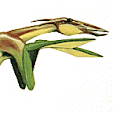 |
| Click to enlarge; copyright Gert van Dijk |
The ballonts as I first envisaged them and have presented them here were 'complete' animals, meaning they carried every organ they needed to live, including digestive organs, membranes, nervous systems, etc. But I had also played with another way of using ballonts, and that was a more limited version: they might only serve to disperse seeds or larvae. In this view, the gas and membrane would be produced by a much large parent organism, itself definitely heavier than air. The sketch above shows one expression of that idea: we are looking at something like a water lily, with most of the organism hidden from view below the water's surface. But there are 'ballontogenetic' organs in there; you can see one larva that has just been released, while another is in the process of getting its balloon filled. The idea was that the parent inflates the sac, and that, once released, the larva passively plugs the vents through which the parent injected gas.
 |
| Click to enlarge; copyright Gert van Dijk |
 |
| Click to enlarge; copyright Gert van Dijk |
Now this apparently similar scheme rested on another mechanism to form the membrane. Here, a kind of microbial mat under and on a water surface has the ability to produce a lighter-than-air gas, perhaps methane. The gas would push the surface layer of the mat upwards, forming a bulge. As the volume of gas increased, the bubble lifts the membrane up some more. It might dry out to become lighter, while also shrinking at the bottom, forming a kind of tether. I admit that it was not quite clear to me what kind of membrane there would be to keep the bubble intact. If you look closely, you will see that there is a definite round structure within the outer slime mat. What that was, and how it would work, wasn't exactly thought through: while sketching, shapes just coalesce, and the process is only partly a conscious one. With hindsight, I can now add one word that might perhaps solve this problem: foam. But more about that in a later post.
I really liked the concept of some witches' microbial brew forming slimy mats that would in the end produce a nice ballont, carrying the whole microbe culture to wherever the winds would take it.
 |
| Click to enlarge; copyright Gert van Dijk |
This one is very similar, just a bit more worked out, and more pleasing as far as its potential for a painting was concerned. ( I do not know why I wrote 'Colonia volitans' underneath; that should be 'Colonia volans', the 'flying settlement'.)
 |
| Click to enlarge; copyright Gert van Dijk |
Actually, I could not resist spending an additional 15 minutes on it, quickly adding some colour to see whether life could be injected into this old sketch. It's not too bad, I think; something like this may work artistically.
Something new for this blog
While 'artistically pleasing' is certainly important when designing speculative lifeforms, it is not the only thing requiring artistry. There has to biological and physical feasibility too, and those are not easy either. Please keep in mind that the sketches above unfortunately rested on a complete lack of physical feasibility, and that is why they were banned. The previous posts and comments made it clear that small ballonts really need a 'magical massless membrane'. But 'massless' is already 'magical', at odds with 'physics'.
Still, one commenter, Abby, short for Abbydon, came up with an ingenious idea. He wrote that graphene membranes might allow for very small and nearly massless membranes. Whether creating graphene biologically is plausible or feasible remains to be seen. But I liked the idea that this might make ballonts at least physically feasible, so I invited Abbydon to do something I have never done before, and that is to write a post for this blog. Mind you, this doesn't mean that previous commenters were less smart; it's just that I never thought to ask anyone to contribute directly to the blog. Abbydon accepted, so you may expect the upcoming post 'Ballonts VIII' to carry his signature.
